When we first started RVing for 4 years we had no clue about the benefits of a Tire Pressure Monitoring System for RVs. We did not put a TPMS system on our first RV, at the time, we didn’t even know such a thing existed. We were BRAND new to the RV experience and learned a lot in the school of “hard knocks.”
Fast forward 4 years and we’ve been using a TPMS system for over two years now. And we will NEVER travel without it again. And why is this? Well, my parents who are also full-time RVers could have DIED had it not been for a TPMS. (More on that later so keep reading). But first, what is a TPMS and what why should you have one?
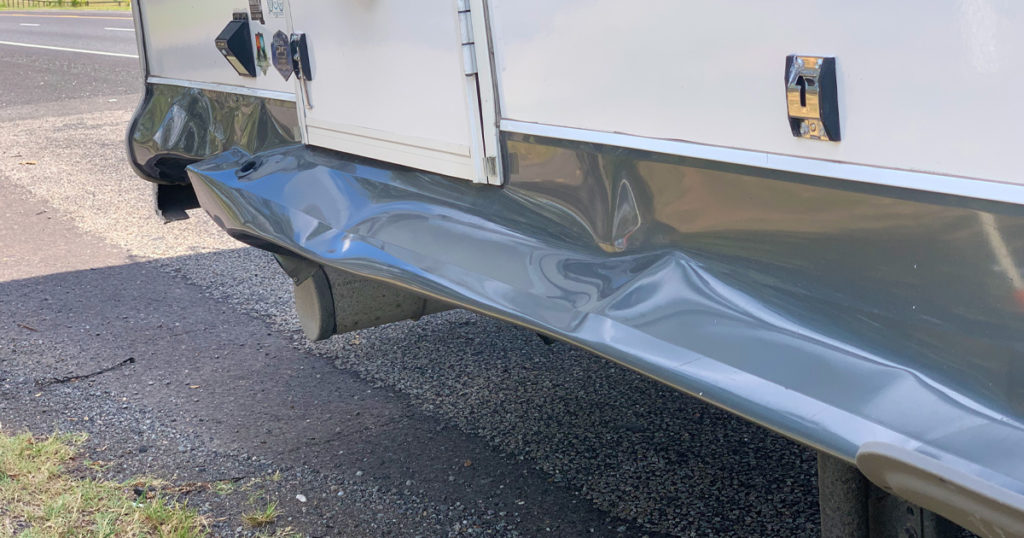
Using a tire pressure monitoring system (TPMS) on your RV is crucial for maintaining the safety and longevity of your vehicle. Here are a few reasons why:
- Improved Safety: One of the main benefits of using a TPMS on your RV is that it helps to improve safety on the road. Underinflated tires can lead to uneven wear and tear, which can increase the risk of a blowout or other tire failure. A TPMS allows you to monitor the pressure of your tires in real-time, so you can quickly identify and address any issues before they become dangerous.
- Increased Fuel Efficiency: Properly inflated tires can also help to improve your RV’s fuel efficiency. When tires are underinflated, they can cause your engine to work harder and use more fuel. A TPMS can help you to ensure that your tires are always at the correct pressure, which can help to save you money on gas.
- Extended Tire Life: Another benefit of using a TPMS is that it can help to extend the life of your tires. Overinflated or underinflated tires can cause uneven wear and tear, which can lead to the need for frequent tire replacements. A TPMS allows you to maintain the correct pressure, which can help to prolong the life of your tires.
- Peace of mind: Knowing the real-time pressure of your tires while you’re on the road, gives you peace of mind, that you are driving on safe tires, it also alerts you to any potential problems so you can take action before it’s too late.
A tire pressure monitoring system is an essential tool for any RV owner. With a TPMS, you can ensure that your RV is always running at its best and that you and your passengers are safe.
On our first trip out with our current rig we still did not own or use a TPMS. We made a rookie mistake this trip out and a TPMS would have prevented this. And I am going to tell you why so keep reading.
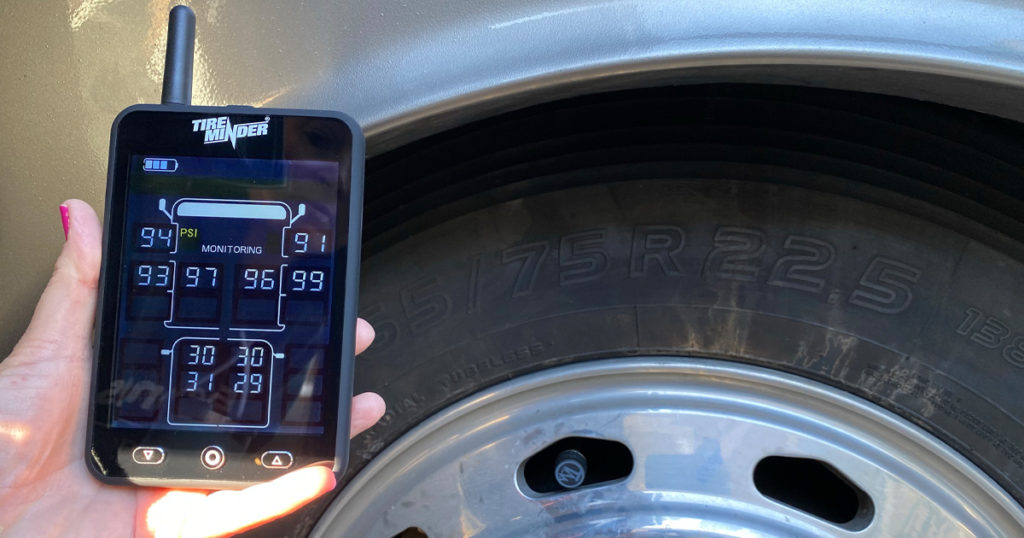
Rookie Mistake Ends In Tire Damage
Pulling into a Walmart for groceries or to take a break from driving is a fairly common occurrence for a lot of RVers, which is what happened that particular day. Our tow vehicle is a 2007 Jeep Wrangler and for this year’s Jeep, the key in the ignition must be turned to the accessory position in order to unlock the steering to move Greeley behind the RV when towing. When pulling over for a break for longer than a few minutes, we typically pull the key out of the Jeep ignition and lock the doors for security, save battery, and anti-theft reasons. I’ll bet you are guessing where this is headed.
When pulling out of the Walmart, we had forgotten to TURN the key to the right position to unlock the steering. This causes the steering wheel to be locked and unable to turn freely as corners are turned. Because our RV has such a large and powerful diesel engine, there was no feeling of “drag”, we can hardly tell the Jeep is behind us. However, since the wheels were locked to one side, the RV was now pulling to the left. Not aware of the issue, we dismissed this as it was also slightly windy. We decided maybe the wind was causing the pull. That is until we drove through an area with two large hills on either side. We closely paid attention to see if the “pull” continued as we drove through this stretch of road. And the pull did NOT change, so we knew there was something going on and it was not the wind.
We got out and looked around the RV and did not see anything unusual. So, we checked the Jeep and we are now smelling a burning rubber smell! The two front tires were hot to the touch! Small bits of tiny rocks were also stuck to the hot rubber tread of the tires. We realized right then and there – the steering had been locked in place and was dragging the Jeep behind us.
Why An RV TPMS Would Have Prevented A Problem
Now we know a TPMS will monitor tire pressure and temperature at the same time, we would have KNOWN there was a problem right away. A TPMS would have alarmed for an over temp tire (if we had one installed at the time).
From this point forward, we decided to always use a TPMS when traveling. We purchased a system and have used it ever since. We have not had any more “close calls” with our RV or our tow vehicle. There is also the peace of mind that comes with knowing if we have a problem, we will be alerted. If a tire is leaking air, getting too hot, or increasing in pressure, an alarm will sound so we know to pull over and check on things before it’s too late.
My Parents Could Have Died – The RV TPMS Saved Them
My parents are retired and RV full-time. On their way to Florida this year, they experienced a situation that could have resulted in not only worse damage to the trailer but even death.

What happened was unbeknownst to them, they lost an entire wheel/tire off their 5th wheel trailer. Yes, you read that right. For some reason, ALL of the studs broke off the axle and the ENTIRE tire and wheel assembly came off. They did not KNOW this happened. They heard nothing, saw nothing, and did not know they were now only riding on 1 wheel on the right side of the RV.
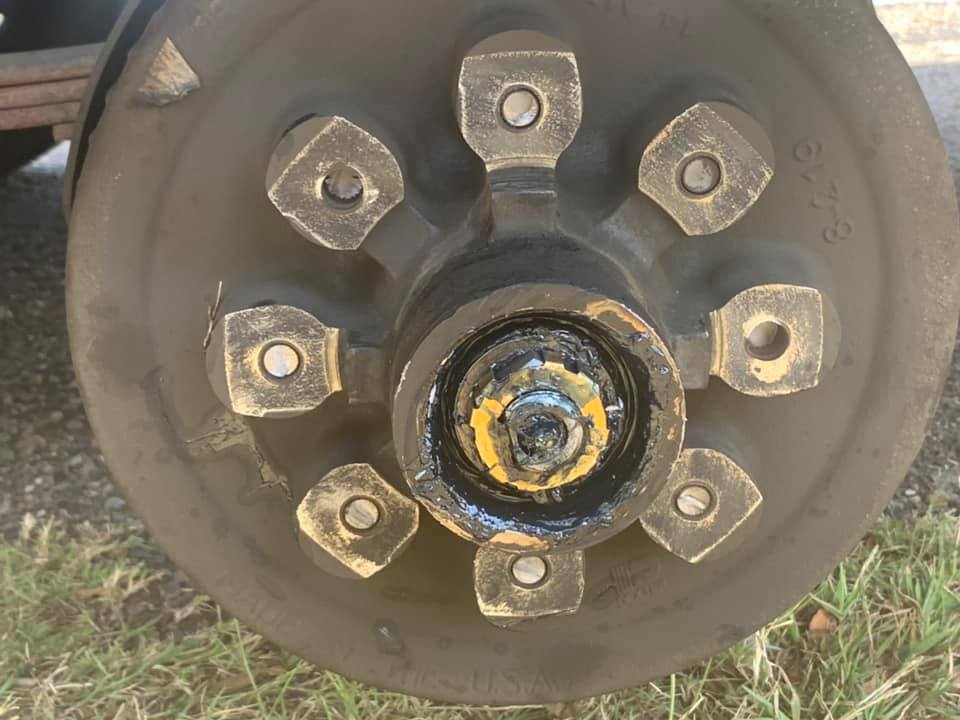
The TPMS alarmed that the remaining tire was over 100 PSI. They pulled over to check the tire and it was then they realized what happened. The reason the tire pressure was so high was that ALL of the weight of the RV was riding on that remaining tire on that side.
Now, let’s talk about what would have happened IF they had not been using a TPMS. First of all, they would have not known there was ANY issue at all until it was too late. That remaining tire WOULD have blown out and with the other tire and wheel completely missing, the trailer could have flipped over. If a trailer flips over it most of the time will also flip the vehicle it’s attached to as well. Especially going down the highway at 55 MPH, this situation could have been very tragic indeed. The TPMS literally saved their lives. You can see the whole story as told by my dad in our recent video on our YouTube channel.
What Type Of RV TPMS Do You Need?
What type of system you need depends on your setup. Are you towing an RV travel trailer or 5th wheel? Do you have a motorized RV? Are you towing a car behind your motorized RV? If you are driving a vehicle and towing, chances are you have a built-in TPMS for the vehicle you are driving and you just need a TPMS for your RV that you are towing.
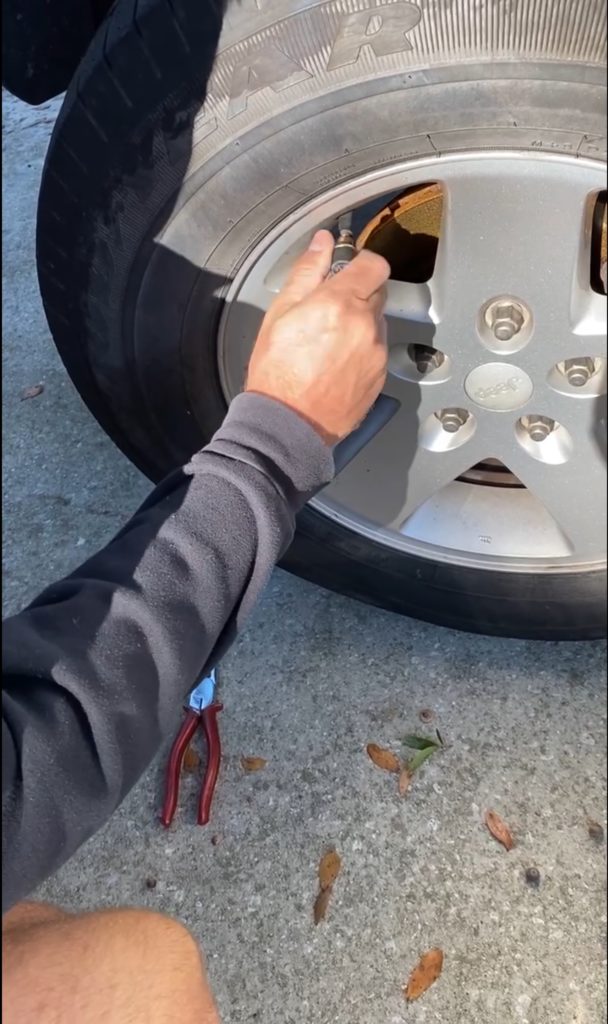
If you are driving a motorized RV you will want to make sure to have a TPMS for both the motorized RV AND any vehicle you are towing behind your RV. For example, we have a 10-sensor set. 6 sensors for our motorhome (it has 6 tires and wheels) and then 4 sensors for our Jeep. It’s important to know if we have a flat tire on our Jeep as we would never feel any drag in the motorhome. This is actually how most tow car fires start. A tire goes flat, overheats, and starts on fire. The driver of the motorhome never realizes there is a problem until they see smoke or flames in their rearview mirror or camera. This can all be AVOIDED by using a TPMS.
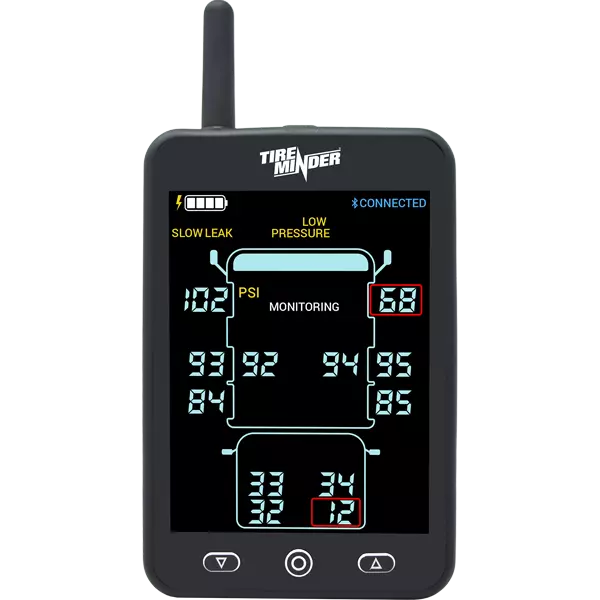
Which TPMS Is Best For RVers?
There are several TPMS systems on the market. We have used the TST TPMS in the past and it does work well. The only downside we’ve experienced with the TST is when replacing batteries in the sensors (you WILL need to replace the sensor batteries at some point) it’s like performing a delicate surgery. The replacement batteries for 10 sensors run around $20.
There are two types of sensors. Flow through sensors (sensors that screw onto the valve stems and the air “flows through” them if you need to add air to a tire) and cap sensors. The cap sensors can be easier to install and similar to a small, screw-on cap for valve stems, they need to be unscrewed to add air to a tire when needed.
We just switched over from the TST to the TireMinder TPMS. The TireMinder A1AS is the system we are using now and has a full-color screen as well as an app that can be used to check the status of the tires. One of the things we’ve learned that helped us make the switch over to TireMinder is they provide FREE replacement batteries for the life of the system. You can email, call or find a TireMinder booth at an RV show or rally and get a FREE pack of replacement batteries.
Save 5% Off A TireMinder TPMS For Your RV
We’ve partnered with TireMinder and TechnoRV to be able to offer 5% off a TireMinder system. Use code GLAMPER5 at checkout to get a discount. You cannot get this cheaper on Amazon, e-trailer, or camping world.
We also have a ton of other deals we’ve been able to score too for the RV Community on our Partners page. Make sure to check it out and see the various discounts and codes we’ve secured for our readers and fans!

Very glad your parents are OK.
The big question should be, why did this happen. All the studs don’t just break off. I hope the new studs fixed the problem. Also I don’t know why the pressure indication went up when they lost a tire (but good it did for what ever reason) as pressure does not change when you put more weight on a tire. If it did when the tech at the shop puts in the air before mounting (which they do) it would go up when the car weight is put on the tire and it doesn’t.
Personally, I would have that drum assembly completely replaced. What if those studs breaking and tire coming off cause cracks in the drum? Is their safety worth the $200 or so to replace it? Just me, I am very keen on safety.
P.S. Over torqueing the lug nuts could have cause them to break (or a few and then it cascaded). I would see what the MFg. torque rating is for those lug nuts and put a sign on or about the wheel stating “Hand Torque Only” and then the torque value.
Great Tips! Thanks, you have some really good and valid points here. We are just glad they had a TPMS to alert them and hopefully this won’t happen again in the future.
Thanks!
great points.
I went on Rte 301 in Virginia about two miles from the Nice Bridge. My tire lost 20lbs of pressure and kept failing. Thankfully, the Tymate tire pressure monitoring system alerted me to a loss of pressure in the rear right tire on my dual-axle fifth-wheel camper. I like the ability of this device to monitor three tire parameters in real-time, including tire pressure (current, low, and high), temperature, and air leaks quickly. The last person I love. There’s also a low battery indicator for the sensor, allowing RV owners to determine when the part needs replacing.